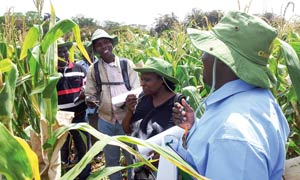By Florence Sipalla

Photo: Biswanath Das/CIMMYT
Many smallholder farmers in Africa can only afford to apply small amounts of fertilizer to their maize crop. Fertilizer-friendly maize, bred to more efficiently use the small quantities of fertilizer that farmers apply, is helping to address this challenge. On 8 and 25 July, the Improved Maize for African Soil (IMAS) project, led by CIMMYT, hosted two field days at Kiboko, Kenya, to showcase fertilizer-friendly pre-commercial maize hybrids and inbred lines. CIMMYT also held a similar field day on 4 March in Harare, Zimbabwe attended by 50 partners from the southern Africa region. The event was organized by CIMMYT breeder Dr Amsal Tarekegne.
Thirty-three partners representing seed companies, non-governmental organizations (NGOs) and national agriculture research systems (NARS) from Kenya, Tanzania and Uganda participated in the field days. They were able to evaluate and select IMAS pre-release hybrids and advanced inbred lines. “The focus of the IMAS line development pipeline is nitrogen use efficiency, which has been added to other adaptive traits relevant for Sub-Saharan Africa,” said Dr. Biswanath Das, breeder and co-leader of the IMAS project. “The germplasm is very diverse, incorporating nitrogen use efficiency from Latin American and temperate sources in the Africa-adapted materials,” said Das. Over 3,000 advanced inbred lines were on display at Kiboko for selection by partners.
The deadly maize lethal necrosis (MLN) disease has emerged as a primary challenge to maize breeding in the East African region. “The lines displayed at Kiboko are also being evaluated in parallel for their responses to MLN at the MLN Screening Facility at Naivasha,” said Das. The results from the trials at Naivasha will further help partners in making use of selected germplasm in their breeding programs.
“I gained insight into the work that IMAS is doing,” said Saleem Ismail, chief executive officer of the Western Seed Company. Ismail said that he had selected germplasm from this field day; “I plan to cross these materials with my testers for evaluation in western Kenya.” He added that he would like to see how the germplasm combines with early- and late-maturing materials.
“This germplasm is very useful,” said Wilson Muasya, a breeder with Kenya Seed Company. “You never see this kind of germplasm assembled in one place. We can diversify and improve our germplasm and our own varieties,” added Muasya. “We can also identify materials that can effectively fight the MLN disease.”
Philip Leley, a maize breeder with the Kenya Agricultural Research Institute (KARI), Muguga Station, said he wanted to introduce diversity into KARI’s maize breeding program, especially for traits such as nitrogen use efficiency and MLN tolerance.
Partners from BRAC, one of the largest NGOs in the world, and Nuru International, an NGO based in Kenya, also participated in the field visit. Shahadat Hossain of BRAC-Uganda and Peter Wangai of Nuru International were keen to identify hybrids that could be marketed to their target farmers. In 2013, Nuru International worked with 6,000 farmers in Kenya’s Kuria district, and plans to expand to 10,000 farmers by next year.
“We provide farmers improved seed and fertilizer for one acre of land,” said Wangai. “We also advise them on varieties to plant,” explained Wangai, who indicated that the organization is eager to identify maize varieties that can tolerate MLN. “We are discouraging farmers from planting maize in the short rain season because of MLN,” he said, explaining that part of Nuru’s extension service is to advise farmers on how to manage the spread of MLN.
BRAC provides integrated services in agriculture, health and microfinance in several countries in Africa, including Tanzania and Uganda. “Since 2000, we have trained more than 100,000 farmers in Uganda,” said Hossain. The NGO provides different types of seed to farmers including maize, rice and vegetables. “We have BRAC-branded maize open-pollinated varieties,” said Hossain. “We currently procure hybrids from a commercial seed company in Uganda but plan to put our own hybrids on the market in the future.”
“Organizations such as BRAC and Nuru International help to diversify the suppliers of CIMMYT’s improved maize germplasm. Together with other development partners in the region, they play a very important role in ensuring that thousands of smallholder farmers have access to new improved varieties, as well as information,” said Das.
 Capacity development
Capacity development